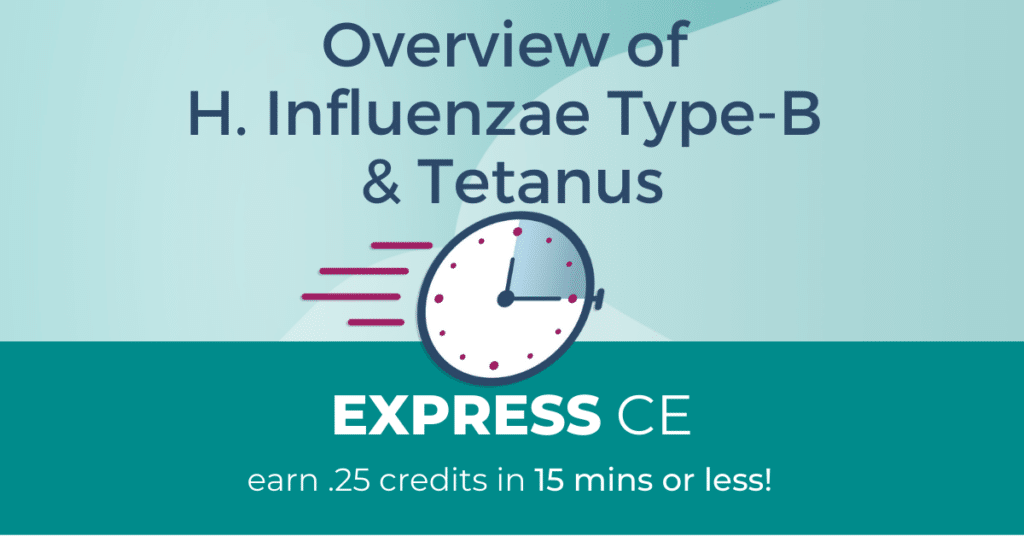Pete Kreckel, microCE, 0.25 hours
My sister Mary Kreckel Fritz is a registered nurse who graduated from Philipsburg State Hospital School of Nursing in 1980 has vast experience in the area of pediatrics. In regard to this topic, she had this to offer:
“ We had several kids with epiglottitis, they were either intubated or had a tracheotomy. They were one-on-one nursing care because if they pulled out their tubes you lost their airway. The endo tube and trach tube stayed for a few days until the swelling in the epiglottis went down.
These kids were easily diagnosed because they would lean forward with constant drooling with respiratory distress. I would have to comfort them by hugging them while they were restrained from pulling out their tubes. When parents in the pediatrician’s office were reluctant to give vaccines, I always told them how epiglottitis has been eradicated because of the vaccines.”
Table of Contents
Haemophilus influenzae type-b
H. influenzae type b was the leading cause of invasive bacterial disease among children in the United States prior to licensing of Haemophilus b conjugate vaccines in 1987. The bacterium also causes pneumonia, meningitis, epiglottitis arthritis, cellulitis, and blood infections. Centers for Disease Control and Prevention (CDC) now estimate that H influenzae type b disease in children under the age of 5 years has been reduced by 95%.
The organism was given the name Haemophilus by Charles-Edward Winslow, et al. in 1920. It was not until 1933 that it was established that influenza was caused by a virus and that H. influenzae was a cause of secondary infection. Haemophilus influenzae is an aerobic gram-negative bacteria with a polysaccharide capsule with six different serotypes (a-f) of polysaccharide capsule.
- influenzae enters the body through the nasopharynx. Organisms colonize the nasopharynx and may remain only transiently or for several months in the absence of symptoms (asymptomatic carrier). This bacterium does not survive on inanimate surfaces. Hib could be isolated from the nasopharynx of 0.5% to 3% of healthy infants and children but was uncommon in adults.
Before effective vaccines were introduced, it was estimated that one in 200 children developed invasive H influenzae type b disease by the age of 5 years. In children less than 5 years of age, the mortality rate for invasive H influenzae type b disease ranged between 3% and 6%.
Meningitis: In more than 60% of these children, meningitis was the clinical syndrome and permanent sequelae ranging from mild hearing loss to mental retardation affecting 20% to 30% of all survivors.
Epiglottitis (a swelling of the cartilage covering the windpipe, which can block the flow of air into the lungs): The demographics, causative organisms, and natural history of epiglottitis have changed substantially in the Hib vaccination era. Routine Hib vaccination for infants has made epiglottitis rare in children. It’s now more common in adults. Truly an example of “herd immunity”.
Vaccine history:
- A pure polysaccharide vaccine was licensed for use in the United States in 1985 and was used until 1988. The vaccine had low efficacy and is no longer available in the United States.
- The first Hib conjugate vaccine was licensed in 1987. Conjugation is the process of chemically bonding a polysaccharide to a more effective protein carrier. This process changes the polysaccharide from a T-independent to a T-dependent antigen and greatly improves immunogenicity, particularly in young children.
Dosage of available vaccines:
MONOVALENT VACCINES:
- ActHIB®:4-dose series (3 dose primary series at age 2, 4, and 6 months, followed by a booster dose* at age 12–15 months)
- Hiberix®:4-dose series (3 dose primary series at age 2, 4, and 6 months, followed by a booster dose* at age 12–15 months)
- PedvaxHIB®: 3-dose series (2-dose primary series at age 2 and 4 months, followed by a booster dose at age 12–15 months
COMBINATION VACCINES:
- Pentacel® (DTaP-IPV/Hib) 4-dose series (3 dose primary series at age 2, 4, and 6 months, followed by a booster dose* at age 12–15 months)
- Vaxelis® (DTaP-IPV-Hib-HepB): 4-dose series (3 dose primary series at age 2, 4, and 6 months, followed by a booster dose* at age 12–15 months)
- *Vaxelis® ((DTaP-IPV-Hib-HepB): is not recommended for use as a booster dose. A different Hib-containing vaccine should be used for the booster dose.
- Vaccines are interchangeable and should follow a 3-dose schedule if more than 1 brand is used
- Hib vaccines should be given at the same visit as other recommended vaccines.
Rates of vaccination: Among children born during 2016–2017, 92.2% had received the Hib vaccine primary series (at least 2 or 3 doses, depending on product) and 79.9% had received the full series (primary series and booster; at least 3 or 4 doses, depending on product type) by age 24 months.
Are the vaccines working? You betcha!!
Hib Secular Trends in the United States
- About 20,000 cases of Hib annually before vaccine
- Incidence of Hib has declined 99% since the pre-vaccine era.
- Clinical efficacy has been estimated at 95% to 100%. Invasive Hib disease is uncommon in children who are fully vaccinated.
- From 2009-2018, 36 reported cases of Hib in patients younger than age 5 years
- Secondary cases of Hib are rare (illness occurring 1-60 days following contact with an ill person)
TETANUS
Tetanus is caused by bacteria known as Clostridium tetani, which is an anaerobic bacteria found in the soil. Clostridium tetani resides in the gut of mammals. C. tetani spores can survive autoclaving at 249.8°F (121°C) for 10 to 15 minutes. When the bacteria invade the body, they produce a toxin called tetanospasmin, that causes painful muscle contractions and stiffness, usually all over the body. This occurs by the tetanus toxin entering adjacent inhibitory interneurons, where it blocks neurotransmission by its cleaving action on the membrane proteins involved in exocytosis of the nerve cell. One of the cardinal features of tetanus: intense, painful spasms of the masseter muscles, and an inability to open the mouth, known as trismus or more commonly, “lockjaw”.
It can lead to tightening of muscles in the head and neck, so you can’t open your mouth, swallow, or sometimes even breathe. Patients have facial paralysis called “Risus Sardonicus” known as “the smile of the devil.” Tetanus kills about 1 out of 10 people who are infected even after receiving the best medical care. Is rare in the US, thanks to our vaccine efforts.
“Help I stepped on a rusty nail”
A clean nail will cause tetanus just as efficiently as a rusty nail. Other opportunities for entry of tetanus includes gunshot wounds, compound fractures, burns, and unsterile intramuscular or subcutaneous injections (that often occur in injection drug users). What needs to happen for tetanus to occur is:
- Any injury that penetrates the skin, that results in the inoculation of C. tetani spores. Any foreign body increases the risk.
- Other bacteria present creating a mixed wound infection
- Tissue breakdown
- Localized ischemia
- The incubation period is usually about 8 days, with a usual range of 1 to 3 weeks.
Other opportunities for tetanus infection includes:
- Infection of the umbilical stump in neonates
- Obstetric patients (after septic abortions)
- Bowel flora growth in post op patients
- Animal or insect bites
- Dental abscesses
- Diabetics with mixed wound infections on the extremities
- Injection drug users. C. tetani spores can be found in contaminated heroin.
Clostridium family reunion:
Clostridium are gram positive anaerobic bacilli. The grow best when there is no oxygen.
We health care practitioners are very familiar with the “star” of the clostridium family, C. difficile. However, there are other members of this family we need to avoid as well:
- Clostridium botulinum: can produce botulinum toxin in food or wounds and can cause botulism. Can cause muscle paralysis. Clostridium botulinum can form spores that are very, very heat resistant. Even hours in the boiling water canner will not kill it. (source: www.foodsafety. gov)
- Clostridiodes difficile can flourish when other gut flora bacteria are killed during antibiotic therapy, leading to superinfection and potentially fatal pseudomembranous colitis (a severe necrotizing disease of the large intestine).
- Clostridium perfringens causes a wide range of symptoms, from food poisoning to cellulitis, fasciitis, and gas gangrene.
- Clostridium sordellii can cause a fatal infection in exceptionally rare cases after medical abortions. no oxygen.
TREATMENT:
Tetanus immune globulin (TIG) is recommended for persons with tetanus to remove unbound tetanus toxin. Toxin bound to nerve endings is unaffected by TIG. A single intramuscular dose of 500 units is generally recommended for children and adults, with part of the dose infiltrated around the wound if it can be identified. Intravenous immune globulin (IVIG) contains tetanus antitoxin and may be used if TIG is not available. Antibiotic therapy is of little value, unless debridement is done in an aggressive manner.
VACCINATION
The development of tetanus toxoid occurred in 1924. It was first widely used during World War II. After the 1940s, tetanus declined steadily. Since the mid-1970s, about 50 to 100 cases have been reported annually in the United States. More recently, from 2009–2018, an average of 29 cases were reported per year, thanks to our vaccination efforts.
When discussing Tetanus vaccines
- Td contains reduced amounts of diphtheria toxoid compared with DT.
- DTaP and Tdap contain the same acellular pertussis components, but Tdap contains a reduced quantity of some pertussis antigens and diphtheria toxoid. Boostrix® contains a reduced quantity of tetanus toxoid compared to Infanrix®.
- Children younger than age 7 years should receive DTaP vaccine or DT vaccine (if not covering pertussis)
- Persons age 7 years or older should receive Td vaccine or Tdap vaccine, even if they have not completed a series of DTaP or DT (Tdap would be off-label for children age 7 through 9 years, but is still recommended by ACIP).
- Tdap (Boostrix® by GSK) is approved for persons age 10 years or older to any age
- Tdap (Adacel® by Sanofi-Pasteur) is approved for persons age 10 through 64 years.
- Note: Either vaccine administered to a person age 65 years or older is immunogenic and would provide protection. A dose of either vaccine would be considered valid.
- For complete immunization schedule consult CDC
- Tetanus antitoxin levels decrease with time, so boosters are recommended every 10 years
- Small percentage of individuals are unprotected before 10 years, so booster for wound needed if more than 5 years have elapsed since last dose.
Further reading: https://www.cdc.gov/vaccines/pubs/pinkbook/tetanus.html#epi
Have a Great Day on the Bench!!







